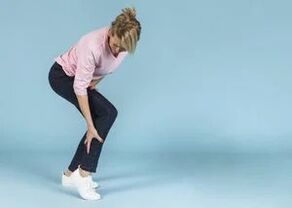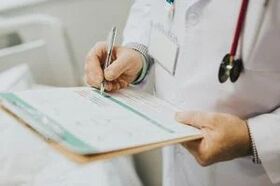Angiosurgenous argue that varicose veins are such a pathological process as a result of which the venous wall changes with the subsequent valve deficiency.
Reasons
The exact causes of varicose veins are not yet known.Based on epidemiological studies, it was found that a genetic predisposition affects the pathological process.

The predisposing factors are also known, of which varicose veins may appear:
- violation of the hormonal background (menopause, estrogen intake);
- overweight;
- pregnancy;
- long static loads;
- wearing tight linen;
- constipation;
- surgical intervention (arteriovenous deviation);
- Development defects or obstruction of deep veins.
How it is?
As varicose veins are a modification of veins, the pathology is classified not only for vascular diseases, but also for cosmetic problems:
- Patients first notice the occurrence of a venous pattern in the legs or the appearance of mesh veins.
- Later, the veins become convincing, increase the skin.
- In the distant stages, the varicous nodes are clearly visible, representing the confusion and expansion of venous vessels.
Violation of tissue trophism leads to a change in skin pigmentation.
Stages (degree)
Several stages, or degrees, varicose veins are distinguished.With the varicose veins of the 1st degree in patients, the heavy leg syndrome of so is only diagnosed.Often patients complain of cramps in the calf muscles and swelling, which disappear after rest.
With 2nd degree varicose veins, persistent edema occurs, pigmentation of impaired skin, stagnant dermatitis.In advanced cases, trophic ulcers appear in the third degree of disease.
The value of prevention
Knowing the predisposing factors of the occurrence of the disease, attention should be paid to the prevention of varicose veins:
- Wearing comfortable shoes and underwear;
- Minimization of labor associated with static loads and extended legs in the legs;
- Physical Education classes;
- Vitamin reception: C, E, PP;
- Power correction.
If there is no way to change the work that is the cause of the occurrence of the disease, it is recommended to unload the gymnastics during the day and the drainage massage at night.Using elastic bandages and a contrast shower will help prevent the disease.
Signs
The symptoms of varicose veins are diverse.The clinical picture depends on the course of the disease and the location of the process of varicose veins.
Leg varicose
The initial signs of varicose veins are:
- gravity in the legs;
- Stress in the legs;
- fatigue when walking;
- Ankle articulation pasture (usually at night);
- seizures;
- Pain throughout the increased veins.
In women, symptoms are growing before menstruation.After rest, unpleasant sensations in the legs disappear.
Lymphatic deficiency in varicose veins leads to the development of cellulite, dermatosclerosis, trophic ulcers and erysipelas.With serious violations of venous flow, patients complain about itching the skin and dry skin in the affected vein area.
Gradually, at the place of violation of tissue trophism, the skin is thinner and atrophic.Hyper or hypopigmentation develops.With the progression of the pathological process, cyanotic points and trophic ulcers appear.

In a pronounced process, patients have complaints about:
- increased fatigue;
- heartbeat;
- shortness of breathe.
These signs are associated with increased cardiac muscle load in connection with blood tank to the venous line.
Reticular varicose veins from the lower ends
A special manifestation of varicose veins is the reticular varicose veins.Clinical manifestations of the pathology:
- increasing the local temperature in the ankle joint;
- fatigue and weight of the legs;
- Dense subcutaneous fabric.
Varicose veins of the esophagus
With a varicose expansion of the veins of the esophagus, a conviction appears and the bags of blood vessels.The main cause of disease development is portal hypertension.
The disease manifests itself by the following signs:
- Esophageal inflammation;
- burning, belching;
- anemia;
- Difficulty swallowing food.
A dangerous complication of pathology is the massive bleeding of the veins.The patient vomiting with blood, hypotension, tachycardia, impaired consciousness.
Uterus varicosis
The forms of internal varicose veins include varicose veins of the uterus.The main reasons for the change in veins:
- physical activity;
- chronic constipation;
- pregnancy;
- taking hormonal contraceptives;
- Development abnormalities;
- Abortion.
Women with uterine varicose veins are complaining of lower abdomen pain, violation of the menstrual cycle.The disease can lead to infertility.
Varicose veins of the lips
This type of varicose veins in pregnant women can develop from the second month of pregnancy.The disease develops whether there was pelvic thrombosis or congenital angiodysplasia.
How are the varicose veins:
- expanded veins of the vulva;
- Skin combs as a result of itching;
- swelling.
The disease is accompanied by disurric disorders, popping in the perineum.The danger is the development of acute thrombophlebitis, a rupture of a damaged vase.
Varicose veins of a small pelvis
The first signs of varicose veins are pulling pain in the lower abdomen.There are several options for the course of this form of the disease:
- varicose veins and vulva;
- PLERY PLETOR PLETOR.
Clinical manifestations of pathology are observed in 30% of women during pregnancy.The disease is a purely feminine pathology.
The venous infinity manifests itself by the following signs:
- gravity and pain;
- pain during sexual intercourse;
- Dysmenorrhea;
- Urination disorder.
Varicocele
The varicosis of the seed cord in men is called varicocele.The disease leads to a violation of the venous output of the testicles.Patients complain about pulling scrotum pain, erectile dysfunction.When examining the testicles, the expanded surface veins, the scrotum asymmetry are visible.The reasons for the development of the disease include:
- physical activity;
- Congenital deficiency of connective tissue;
- Tumors in retroperitoneal or pelvis space.
With the progression of the pathology, spermatogenesis is disturbed, which leads to infertility.The disease can be complicated by bleeding the affected vessels.
Varicose dermatitis
In addition to the characteristic clinical symptoms of progressive varicose veins, their complication should be observed - stagnant dermatitis.In patients, the skin over the affected veins begins to become thinner and itching.In places of inflammation, dark or clear blemishes and peeling appear.
The location of venous dermatitis is the leg and ankle joint. With Combs, the pathological process applies to healthy tissues.If the problem is ignored, inflammation will enter a varicose eczema.
Varizem eczema
Inflammation is stubborn with periods of remission and relapse.Skin injuries are severely treated even after humans.Due to a violation of microcirculation, the liquid part of the blood is infiltrated by the walls of the affected vessels.In the area above varicose veins, the swelling and crying areas appear.
Bubbles full of serous or serous content occur in the legs.With combs, an infection enters the wounds.Mixing, small bubbles form papules.After opening the vesicles, the crusts appear.The curing site is decreased and covered with scales.During the period of exacerbation, vesicles occur again.The progression of the pathology leads to the formation of trophic ulcers.
Pain as a sign of the disease

Often patients complain of pain to varicose veins, which is improved by palpation of the affected vessel.In the early stages, the signal is manifested a little.One person feels weakness and pain at the end of the day.In the morning, after rest, the symptoms disappear.In the final stages, pain syndrome occurs at night.
A combination of pain and seizures at night or after prolonged standing on the legs is considered a classic manifestation of varicose veins.
Characteristic location of pain for varicose veins:
- Air region;
- Trophyl ulcer zone;
- The calf muscle.
If an increase in total temperature enters, this may indicate the beginning of the inflammatory process in Vienna - thrombophlebitis.
Vascular stars
Vascular stars are called telangocasia.The pathology is manifested by the expansion of small subcutaneous vessels.The skin manifests itself in the form of a network of purple or red vessels.The causes of tenngiectasia may not only be venous deficiency, but also:
- Connective tissue diseases;
- Hepatobiliar System Pathologies;
- Use of hormonal drugs;
- Endocrine diseases.
The vascular mesh manifests itself in the legs, face or buttocks.Telectasia is not a separate disease, but acts as a symptom, representing another cosmetic defect.
On the face
On the face, the appearance of a hair mesh is called rosacea.It appears in case of violation of the rheological properties of the blood, with hypertension or diseases of the digestive system, the negative effects of low temperatures or when drinking alcohol.
In women, the main cause of tenngiectasia is hormonal restructuring.The gold standard to eliminate the defect is laser coagulation.
On the feet
In the legs, the vascular mesh appears as a result of venous stagnation.Violet networks usually accompany the varicose veins.As telengiectasia diseases advance, increase.Even after removal of the veins, the hair mesh remains.The methods of their elimination are scleroderma, radio frequency ablation, coagulation of the endovasal laser.
How to get rid of?
Before getting rid of varicose veins, they are performed by comprehensive diagnoses.Patients have laboratory methods of blood and urine examination, reflux detection for subcutaneous veins, functional samples.Of instrumental techniques, they are assigned:
- Duplex ultrasound or triplex scanning;
- X -ray hired phlegography;
- Magnetic resonance phlebography;
- Multispiral computer angiography with contrast.
After determining the degree of varicose veins, the question of the application of treatment methods - surgical surgery or conservative therapy.
Who treats?
If the first symptoms occurs, you should contact the clinic to a phlebologist or angiosurgion. In the district medical facilities, surgeons are involved in this disease.It should be understood that the experience and qualifications of those who treat varicose veins play a decisive role in eliminating the problem.Therefore, it is better to contact specialized centers.
What treatment is needed?
With damage to the lower extremity vessels, the following main methods are used:
- surgery;
- sclerosing therapy;
- Conservative treatment.

In advanced cases, the methods are combined.In chronic venous insufficiency, with damage to the blood vessel valve apparatus and signs of thrombophlebitis, vein removal (phlebectomy) is indicated.Surgical intervention methods with the minimum nature of the invasion include:
- Thermal vein ablation: radio frequency, laser, microwave, steam;
- Non -ertic ablation: chemical with sclerosurizing and menochemical drugs.
To reduce the symptoms of the disease, systemic therapy is prescribed by medications.Patients are prescribed:
- antibiotics in inflammatory processes and trophic ulcers;
- Anti -Septics;
- Phleboprotectors;
- tissue repair stimulants;
- Anticoagulants;
- topical steroids with trophic ulcers;
- Local use of drugs containing heparin.
The condition for the effective elimination of varicose veins is compression therapy using elastic bandages, golf, fair pants.A popular bandage method is a zinc-curative dressing for trophic disorders.
What helps best?
The preparations and compression bandages (meshes) are prescribed only by a doctor, considering the stage of the disease, its complications, pathologies that accompany it and the age of the patient.Therefore, what helps better with varicose veins, a phlebologist should say.
It should be understood that treatment with medicines will not eliminate pathology as well as the use of compression meshes.
Varicose veins in most cases are only surgically eliminated in combination with other therapy methods.
How to remove itching?
To get rid of itching with varicose veins, you need to know how to remove it.Doctors prescribe moisturizing therapeutic ointments (you can use children's cream).With severe itching and peeling skin, drugs with hormones are prescribed.
They use herbal decoction compresses with an anti -inflammatory effect (chamomile, calendula, sage, a series, hop cones).
What is dangerous?
The consequences of varic veins include phlebitis, trophic ulcers, thrombophlebitis, menstrual violation, erectile dysfunction, infertility.The formation of a thrombus and bleeding of the affected vessels is what varicose veins are dangerous.
Blood cloths torn from the lower extremities in a second fall in a small circle of blood circulation, causing pulmonary artery thromboembolism.
With bleeding without emergency medical assistance, a person loses a lot of blood.All these complications lead to disability or death without proper treatment.
Conclusions
Varicosis refers to a common pathology.It develops in people with a hereditary predisposition with excessive static and dynamic loads, as well as their prolonged absence.
The disease leads to serious complications;Therefore, if the first signs occur, it is necessary to contact a phlebologist.
You can get rid of the problem only with an integrated approach.
Patients have surgical methods of treatment, medication, use of compression meshes and lifestyle correction.
